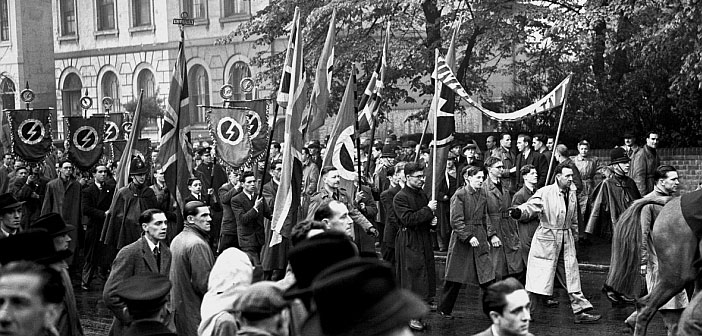Source: Morning Star
DAVID ROSENBERG explains how the far right can be defeated by learning the lessons of the past
They were there to support Tommy Robinson, temporarily held in prison. The emotive themes he had articulated in sound bites in recent times had infiltrated the consciousness of those who took to the streets that day.
That single mobilisation eclipsed even the best-attended National Front rallies of the late 1970s, which rarely surpassed 3-4,000 but caused havoc in immigrant communities. You have to go back to the 1930s to find a similar number mobilised by the British far-right. In 1934, 15,000 people of all classes packed London’s Olympia Exhibition Centre in London. Most of them were avid followers of Oswald Mosley’s vision for Britain and members or supporters of his British Union of Fascists.
Among those in Olympia yet to make up their minds, were 150 MPs underwhelmed by what passed for mainstream politics.
There were also interlopers — up to 100 anti-fascists — who obtained tickets through a clever deception and spread themselves around the hall. In the violence that followed their attempts to heckle, 80 were thrown out bloodied and beaten.
That night Mosley’s thugs won the physical battle but anti-fascists won the propaganda war. The defections Mosley suffered as his brutal methods were revealed forced him to reorientate his movement. It built a new powerbase in working-class districts in London’s East End, surrounding the struggling Jewish ghetto in Aldgate and Whitechapel.
The Battle of Cable Street that took place in that area in 1936 remains a touchstone for anti-racists and anti-fascists today. The size of the mobilisation, the drama of mass blockades and barricades, the clashes with the police, and the incredible people’s victory when fascist movements were advancing in so many European countries, are still recalled as an inspiration to anti-fascists to take to the streets today.
But the ultimate victory over the fascists in 1930s Britain was based on more than one major battle, crucial as Cable Street was.
We can still learn today from the range of strategies through which the far right were undermined. While the informal political alliance that mobilised people to flood the streets against Mosley’s fascists was important — local branches of the Communist Party, Independent Labour Party, Labour League of Youth, rank-and-file trade unionists, and a militant grassroots body that emerged from the community most under attack, the Jewish People’s Council Against Fascism and Antisemitism (JPC) — it was a shared strategy of building an anti-fascist majority locally that was crucial.
This meant recognising that everyone had an active part to play — that a genuinely collective struggle would be far more effective than individual or top-down efforts. It meant acknowledging that the enemy was fascism rather than individuals living hard lives attracted to the fascist flag in the absence of convincing alternatives. The anti-fascist movement recognised that it needed to embed the fight against anti-semitism in the fight for jobs, for education, for better housing, for better lives for all.
While the counter-movement confronted the organised attempts of fascists to march and spread propaganda, it made a conscious effort to win hearts and minds among those who were heading in a fascist direction. It understood that this was not simply a moral issue — saying that anti-semitism was “evil” — but about showing how the fascists were also using anti-semitism as part of a wider attack on democracy that would affect everyone.
Although anti-semitism impacted primarily on Jews, the JPC argued that the “struggle against anti-semitism is as much a task for the British people as a whole as for the Jews, and the struggle against fascism is a task for Jews as much as for the British people as a whole.”
In Britain today, Muslims much more frequently bear the brunt of vicious attacks by racists and fascists, though we should recognise that fascists can attack many targets at once, and a range of migrant and refugee communities also receive their negative attention, boosted by the government’s hostile environment and continuing institutional racism.
The far right accumulate rather than replace targets and anti-semitic incidents are rising once again, not just here, but elsewhere in Europe, especially in Hungary, Poland and Ukraine, and also in the US.
Populist far-right forces, globally, in 2019, are making deeper and deeper inroads into working-class communities, and not just on a narrow propaganda of hate based on stereotyping.
Attacks on women’s rights, gay and lesbian rights, and defence of the “Christian” family also play well for them especially in central and Eastern Europe. We need to spread awareness of the wider set of themes on which they are recruiting and recognise the extent to which they are using online platforms to win support. Our responses need to be smart and collective, but also consciously draw on the insights and strategies of the past to confront the dangers of today.
David Rosenberg is the author of Battle for the East End and Rebel Footprints.

